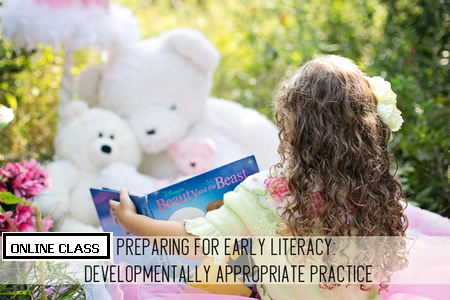Learning to Read: Developmental Milestones on the Road to Literacy
Learn More About Our Online Classes
by: Shannon Kalisher
The process of learning to read is a journey filled with magic, excitement, and fun as well as frustration and impatience. Most of us do not remember how we learned to read (that is the "magic" piece). There are, however, a series of developmental and academic milestones one must move through in order to become a successful reader. Most children relish in the accomplishment of becoming a reader by the end of 1st grade but the road to literacy begins before a child can even talk or walk. Your child's success as a reader is highly dependant on the opportunities s/he is presented with from the very beginning of life.
Below are reading milestones a typical child will master along the road. The lists are not exhaustive but include the important building blocks necessary to become a successful reader. Use these lists as a guide for monitoring your child's progress; however, please keep in mind that just as in other areas of development, growth rates vary among children. If you have further questions or concerns, please visit www.child-works.com.
Infant to age 3
Infants:
- Able to imitate sounds and/or complete words
- Begins to learn the meaning of spoken words (labeling objects, people, etc.)
- Plays games which involve taking turns, repetition, song
- Begins to understand facial expressions
- Develops new ways to express emotions (screaming, laughing, grunting, facial expressions)
Toddlers:
- Recognizes certain books by the cover
- Enjoys being read to, may have favorite books
- Labels objects or characters in a book
- May begin to label specific familiar letters in text
- May pretend to read
Age 3-4 years
- Enjoys listening to and talking about books
- Able to "read" environmental print (i.e. restaurant signs, stop sign, cereal boxes)
- "Reads" favorite text by memory
- Starts to play with and recognize rhyme through song, games, nursery rhymes
- Can identify some letters of the alphabet, may know some corresponding sounds
- May be able to recognize own name in print
Kindergarten
- Enjoys being read to
- Can retell a story including characters and setting
- Pretends to read books using picture clues
- Recognizes most letters of the alphabet (upper and lowercase) and the corresponding sounds
- Understands that print carries meaning
- Knows that text is read left to right, top to bottom
- Can identify and produce rhyming words
- Can determine whether or not two words begin with the same sound < br> o Can identify a small number of "high frequency" words in text (High frequency words are those words that occur often in the English language. Examples of these are the, and, but, because, that, etc.)
- May begin to "sound out" simple words
1st grade
- Has a "toolbox" of strategies to read unknown words (letter/sound relationships, context, word families)
- Can easily decode phonetically regular words using letter/sound knowledge
- Has a lexicon of at least 100 "high frequency words" by the end of the year
- Can self-correct when mistakes are made while reading
- Can make reasonable predictions about an unknown story plot based on the book's title and pictures
- Can read and understand simple fiction and non-fiction
- Can retell a story including: characters, setting, problem, solution
- can count # of syllables
- can segment and blend individual phonemes (sounds) to "break" or "make" a word
- can substitute, add, and delete phonemes in a word to make a new word
As was mentioned above, children move through these steps at different rates and with varying levels of ease and/or frustration. But what should you do if you have significant concerns about your child's acquisition of these skills? The first step is to document your child's areas of strength as well as areas of need specific to reading. What is s/ he good at? What does s/he struggle with and/or not want to do? Next, set up a meeting with your child's teacher. You are your child's best advocate and you may notice something that the teacher has missed. On the other hand, your child's teacher can offer unique insight and observations that provides clarification for your concerns. After discussing your child's strengths and weaknesses, collaborate with your child's teacher and create a plan of action. This plan might include: monitoring your child's progress for a certain amount of time, small group work in the area of reading, strategies that can be implemented at home, a tutor might be in order, and, eventually, in some cases, meeting with the school's pre-referral team will be necessary (a step prior to Special Education testing). Make sure that you feel confident with the plan and of course follow-up regularly to ensure necessary changes are made.
By keeping these reading milestones in mind, you will be better able to make the road to reading a more successful, exciting time for your child. Who knows, you might even catch a glimpse into the "magic" involved in learning to read.
Shannon Kalisher is a literacy specialist and consultant for Child-Works, LLC. Child-Works, "the ultimate parent toolbox", provides consultation in the areas of education, sleep and behavior. Check out http://www.child-works.com literacy activity kits, tutoring services, and small group reading/writing workshops.
Article Source: http://EzineArticles.com/




